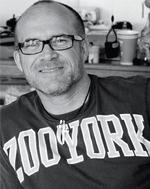Take control of your universe
You can create a brand identity and see it all the way through the process of marketing, but you may need to develop a split personality, says Marksteen Adamson

I remember when I was at art college many years ago, everyone around me seemed to be specialising. It was the thing to do. Some wanted to be illustrators, others typographers, advertisers, photographers or animators.
But I wanted to be all of them. I loved all the subjects and was determined to always have variety in what I did.
When I left I started at Pentagram and Saatchi’s, and ended up at Newell and Sorrell. There I got the chance to create and develop brands within various disciplines.
I did design, packaging, photography, film, and I even composed and recorded music for clients. The only thing missing was ‘above the line’ advertising and a TV ad.
I’d always felt that being creative had no boundaries and specialism was for ants. And I knew I wasn’t an ant.
I believed that as long as you had the right ideas, you could simply apply them to any discipline, from design through to advertising. So when I finally left the corporate world and went out on my own, I wanted to put it to the test.
Our first project, St Kea, started off as a brand identity extended into ambient media that could be marketed.
More recently, our work for Tetley’s new brand product range, Good Earth, has given us the full spectrum, from designing the logo, creating the brand-positioning, designing the packaging, a website with resources, gifts and products, through to a national outdoor campaign and a TV animation ad due to air this month.
Creating brands and then taking them to market forges a complex split personality. The first is about creating equity and the other is about selling and making it famous.
Normally, branding groups try to dictate what ad agencies should do, and ad agencies, not wanting to be dictated to, try to reinvent what design groups are trying to prove. It’s natural, and a tug of war.
But when you do it all yourself it suddenly feels like self-harming. One minute you’re building something delicate, multidimensional and with the hope of it maintaining integrity, and the next you’re on a marketing and advertising soapbox, selling hard and tugging at mass-market heart strings, like my neighbour who has bought a Volkswagen Golf, except it’s an estate. Why didn’t he just get a VW Passat?
It grates and hurts, but it also feels right and grown up – like being in a relationship. One minute you’re having a romantic dinner and the next you’re changing nappies.
The hardest part of working ‘through the line’ is being able to let go once you’ve created the brand, and start to look at your product with a fresh pair of consumer eyes.
If you don’t, you end up creating ads that look like they’ve been done by, and for, graphic designers.
These ads always look the same, are about the design instead of the product, and always have a bad strapline resulting from a client/brand agency workshop. The copy is always unfulfilling and never quite reaches the thirsty parts, and there is always a Power Point visualisation of a billboard that never happened.
If you can do it, there are advantages. You can control the vein of an idea running through the brand experience. And it’s an opportunity to push things a bit further by being unconventional.
Bit by bit, you can educate and inform your audience. It makes it easier to create a complete brand.
But it’s a risk and not always possible. Too many clients rely on research to justify putting new products and advertising into the marketplace, and because of that they end up with the least surprising or imaginative brands.
The advertising becomes disconnected from the product. It simply fulfills a need based on what people know or are already accustomed to. We all know that the best and most-loved brands out there never saw the inside of a research room filled with housewives on red wine.
For me, it’s a dream come true. Having the opportunity to take an idea and then run it all the way through the line is branding at its most fulfilled.
If you want to do it, the key is to have the right business partners who are the opposite to you, and a flexible creative team.
I’m very lucky to be working with my brother-in-law, who has a background in marketing. It keeps us balanced as a team, and with our feet staying firmly on the ground.
Do-it-all survival guide
- The first part of the job is creative, the second part is selling your brand and making it famous
- The selling part can hurt at first – you need to be able to let go of the brand you’ve created
- Stand back and look at your brand through the eyes of the consumer – your campaign needs to focus on highlighting the product, not the beauty of the ad design
- The best and most loved brands out there never saw the inside of a research room
- Pick business partners who are the opposite to you
Marksteen Adamson is a founding partner of Arthur Steen Horne Adamson
-
Post a comment




